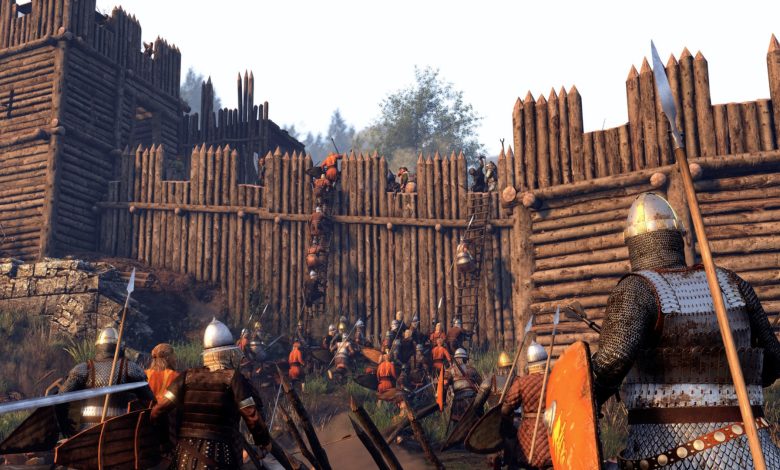Gaming in the Medieval and Renaissance Eras: A Journey Through History’s Pastimes
A Journey Through History's Pastimes

Introduction:
The medieval and Renaissance periods were characterized by tumultuous political upheavals, profound cultural shifts, and significant advancements in various fields. Amidst these developments, games played an essential role in society, providing entertainment, social interaction, and even moral instruction. This article explores the diverse array of games that were popular during the medieval and Renaissance eras, shedding light on the rich tapestry of pastimes enjoyed by people of all walks of life.
Board Games: Strategy and Skill
Board games were a ubiquitous form of entertainment in the medieval and Renaissance periods, enjoyed by both nobility and commoners alike. Chess, believed to have originated in India in the 6th century, became immensely popular in Europe during the Middle Ages, serving as a game of strategy and intellect for the aristocracy. Other board games, such as backgammon, checkers, and Nine Men’s Morris, provided opportunities for socializing, gambling, and testing one’s skill and cunning against opponents.
Dice Games: Luck and Chance
Dice games were another prevalent form of gaming during the medieval and Renaissance periods, offering players the thrill of chance and uncertainty. Games like Hazard, played with two dice, and Fardle, played with three dice, were popular gambling games among both nobles and commoners. Despite their simplicity, dice games could be highly addictive and competitive, with fortunes won and lost on the roll of the dice.
Card Games: From Tarot to Triumph
Card games gained popularity in Europe during the late medieval and Renaissance periods, introduced to the continent via trade routes and cultural exchanges with the Middle East. Early playing cards were hand-painted and intricately decorated, featuring designs inspired by religious, mythological, and historical themes. Games like Tarot, introduced in the 15th century, were initially used for divination but later evolved into a popular form of gaming, with players competing to win tricks and achieve specific combinations of cards.
Outdoor Games: Festivals and Tournaments
Outdoor games and sports were integral to medieval and Renaissance society, providing opportunities for recreation, exercise, and social interaction. Archery, jousting, and falconry were popular pastimes among the nobility, often showcased at tournaments and festivals as displays of skill and prowess. Peasants and commoners enjoyed simpler games like bowling, quoits, and folk dances, which were often accompanied by music, feasting, and merriment.
Role-Playing Games: Theatrical Performances and Masquerades
Role-playing games were a common form of entertainment during the Renaissance, with theatrical performances, masquerades, and pageants providing opportunities for creative expression and communal storytelling. Masquerades, in particular, were elaborate events where participants dressed in elaborate costumes and masks, assuming fictional identities and engaging in playful role-playing scenarios. These events served as a form of escapism from the rigors of everyday life, allowing participants to immerse themselves in fantasy worlds and imaginative narratives.
Educational Games: Morality and Virtue
In addition to providing entertainment, games during the medieval and Renaissance periods often served educational and moral purposes. Moralized chess sets, for example, featured pieces representing virtues and vices, with players tasked with guiding their pieces to victory while avoiding the pitfalls of sin. Similarly, allegorical card games and board games conveyed moral lessons and religious teachings through gameplay, reinforcing societal values and beliefs.
Conclusion:
Gaming in the medieval and Renaissance periods was a diverse and vibrant aspect of society, encompassing a wide range of pastimes and activities enjoyed by people from all walks of life. From the strategic battles of chess to the chance encounters of dice games, gaming provided entertainment, social interaction, and even moral instruction in an era marked by cultural upheaval and change. As we reflect on the games of the past, we gain insight into the values, beliefs, and aspirations of our ancestors, enriching our understanding of history and the human experience.
The Emergence of Modern Gaming: A Journey from Pixels to Virtual Realities
Introduction:
The emergence of modern gaming represents a revolutionary shift in the entertainment landscape, propelled by technological advancements, cultural shifts, and the creativity of developers worldwide. From the humble beginnings of Pong to the immersive virtual worlds of today, this article traces the evolution of modern gaming, highlighting key milestones, innovations, and trends that have shaped the industry.
The Birth of Electronic Gaming:
The seeds of modern gaming were sown in the mid-20th century with the invention of electronic games and devices. In 1958, physicist William Higinbotham created “Tennis for Two,” a rudimentary tennis simulation displayed on an oscilloscope, marking one of the earliest examples of electronic gaming. Subsequently, in 1962, MIT students developed “Spacewar!,” a space combat game played on a PDP-1 computer, which laid the foundation for multiplayer gaming and interactive entertainment.
The Arcade Era:
The 1970s witnessed the rise of the arcade era, characterized by the proliferation of coin-operated arcade machines and the birth of iconic games like Pong, Space Invaders, and Pac-Man. Arcades became social hubs where players gathered to compete, socialize, and immerse themselves in the latest gaming experiences. The success of arcade games laid the groundwork for the emergence of home consoles and the subsequent explosion of the video game industry.
The Console Revolution:
The late 1970s and early 1980s saw the rise of home consoles as a dominant force in the gaming market. The release of the Atari 2600 in 1977 marked the beginning of the console revolution, bringing arcade-style gaming experiences into the living room. Subsequent consoles, such as the Nintendo Entertainment System (NES), Sega Genesis, and Sony PlayStation, introduced innovations like 8-bit and 16-bit graphics, iconic franchises, and immersive gameplay experiences that captivated audiences worldwide.
The Transition to 3D Graphics:
The 1990s witnessed a seismic shift in gaming with the transition to 3D graphics, ushering in a new era of immersive gaming experiences. The introduction of consoles like the Sony PlayStation, Nintendo 64, and Sega Saturn brought polygonal graphics, textured environments, and cinematic storytelling to the forefront of gaming. Games like Super Mario 64, The Legend of Zelda: Ocarina of Time, and Final Fantasy VII pushed the boundaries of what was possible in interactive entertainment, captivating players with their rich worlds and engaging narratives.
The Rise of PC Gaming:
While consoles dominated the gaming landscape, PC gaming also flourished during the late 20th and early 21st centuries. The advent of personal computers and the internet paved the way for a new generation of gamers who embraced the flexibility, customization, and online connectivity of PC gaming. Games like Doom, Half-Life, and World of Warcraft became cultural phenomena, shaping the identity of PC gaming and establishing it as a powerhouse in the industry.
The Digital Age:
The 21st century saw the rise of digital distribution platforms, online multiplayer gaming, and mobile gaming, further democratizing access to gaming and expanding the reach of the industry. Platforms like Steam, Xbox Live, and PlayStation Network revolutionized the way games are bought, sold, and played, offering digital downloads, cloud saves, and multiplayer matchmaking services. Meanwhile, mobile gaming surged in popularity with the rise of smartphones and tablets, introducing new audiences to gaming with accessible, bite-sized experiences.
The Future of Modern Gaming:
As we look to the future, the landscape of modern gaming continues to evolve with advancements in technology, innovation, and cultural trends. Virtual reality (VR), augmented reality (AR), and cloud gaming represent the next frontier of interactive entertainment, offering immersive, accessible, and socially connected gaming experiences. As technology continues to advance and new platforms emerge, the possibilities for modern gaming are limitless, promising new worlds to explore, challenges to conquer, and stories to experience.
Conclusion:
The emergence of modern gaming represents a transformative journey from the arcade era to the digital age, fueled by innovation, creativity, and the passion of gamers worldwide. From the pixelated sprites of the past to the lifelike worlds of today, gaming has evolved into a global phenomenon that transcends boundaries of age, gender, and culture. As we celebrate the legacy of modern gaming, we embrace the endless possibilities of the future, where imagination knows no bounds and the adventure never ends.
The Birth of Electronic Gaming: Pioneering the Path to Interactive Entertainment
Introduction:
The birth of electronic gaming marks a significant milestone in the history of entertainment, laying the groundwork for a multi-billion-dollar industry that captivates audiences worldwide. This article delves into the origins of electronic gaming, tracing its humble beginnings from the early experiments of pioneering developers to the emergence of iconic games that revolutionized interactive entertainment.
Early Experiments and Innovations:
The seeds of electronic gaming were planted in the mid-20th century, as inventors and engineers began experimenting with rudimentary forms of interactive electronic entertainment. In 1958, physicist William Higinbotham created “Tennis for Two,” a simple tennis simulation displayed on an oscilloscope, which is considered one of the earliest examples of electronic gaming. The game allowed players to control a small white dot representing a tennis ball and compete against an AI opponent, demonstrating the potential of electronic technology to create immersive gaming experiences.
The Birth of the Arcade Era:
The true birth of electronic gaming occurred in the early 1970s with the introduction of arcade machines that brought video games out of the research labs and into public spaces. In 1972, Atari released “Pong,” a simple table tennis simulation that became an overnight sensation and kick-started the arcade revolution. Players flocked to arcades to experience the thrill of controlling virtual paddles and competing against friends and strangers in fast-paced, addictive gameplay. “Pong” paved the way for a new era of electronic gaming, inspiring developers to explore new genres, mechanics, and technologies.
The Rise of Home Consoles:
As the popularity of arcade games grew, developers began exploring ways to bring the arcade experience into the home. In 1977, Atari released the Atari 2600, the first commercially successful home video game console, which featured interchangeable cartridges and a library of classic games like “Space Invaders” and “Pac-Man.” The Atari 2600 revolutionized home entertainment, providing players with the opportunity to enjoy arcade-style gaming experiences in the comfort of their living rooms. Subsequent consoles, such as the Intellivision and ColecoVision, further expanded the possibilities of home gaming, introducing innovations like improved graphics, sound, and gameplay mechanics.
The Role of Personal Computers:
While home consoles dominated the gaming landscape, personal computers also played a significant role in the early days of electronic gaming. In the late 1970s and early 1980s, hobbyists and enthusiasts began experimenting with programming and developing their own games for early home computers like the Apple II and Commodore 64. Games like “Adventure” and “Zork” pioneered the text-based adventure genre, immersing players in interactive worlds where they could explore, solve puzzles, and engage with compelling narratives. The accessibility and versatility of personal computers provided developers with a platform to innovate and experiment, laying the foundation for the future of PC gaming.
Cultural Impact and Legacy:
The birth of electronic gaming had a profound cultural impact, shaping the way people play, interact, and consume entertainment. Arcades became social hubs where players gathered to compete, socialize, and immerse themselves in the latest gaming experiences. Home consoles brought gaming into the mainstream, appealing to a broad audience of players and establishing video games as a legitimate form of entertainment. The legacy of electronic gaming continues to resonate today, as modern consoles, PCs, and mobile devices offer increasingly immersive and interactive gaming experiences that captivate audiences of all ages.
Conclusion:
The birth of electronic gaming represents a transformative moment in the history of entertainment, paving the way for a vibrant and diverse industry that continues to innovate and evolve. From the early experiments of pioneering developers to the emergence of iconic games and platforms that shape the modern gaming landscape, electronic gaming has captivated audiences, inspired creativity, and brought people together in shared experiences of play and exploration. As we celebrate the legacy of electronic gaming, we look forward to the future, where new technologies and innovations promise to push the boundaries of interactive entertainment even further.
Introduction to Medieval and Renaissance Games
When it comes to gaming, many people immediately think of video games or modern board games. However, there is a whole world of historical gaming waiting to be explored. Medieval and Renaissance games offer a unique and immersive experience that allows players to step back in time and engage in the excitement and challenges of the past. In this ultimate guide, I will take you on a journey through the fascinating world of medieval and Renaissance games, exploring their history, types, rules, and gameplay. So, put on your armor, grab your sword, and let’s dive into the thrilling world of historical gaming.
History and Origins of Medieval and Renaissance Games
Medieval and Renaissance games have a rich history that dates back centuries. These games were not just a form of entertainment but also played a significant role in the social and cultural life of the time. Many of the games played during this period were rooted in ancient traditions and evolved over time to become the games we know today. One of the earliest recorded medieval games is “Chess,” which originated in India and spread to Persia, the Islamic world, and eventually Europe. Chess was not only a game of strategy but also a reflection of the social hierarchy of the time, with each piece representing a different class of society. Another popular game of the Renaissance period was “Mancala,” which originated in Africa and spread to Europe through trade routes. Mancala was a game of skill and strategy, played with small stones or seeds and a wooden board with hollows or pits. The popularity of medieval and Renaissance games can be attributed to the fact that they provided a form of entertainment, education, and social interaction. These games often reflected the values and ideals of the time, making them a fascinating window into the past.
Popular Types of Medieval and Renaissance Games
Medieval and Renaissance games encompass a wide range of types, each with its own unique characteristics and gameplay. Here are some of the most popular types of games from this era:
Strategy Games:
Strategy games were highly valued during the medieval and Renaissance periods. These games required players to think strategically, plan their moves, and outwit their opponents. Chess, as mentioned earlier, is a prime example of a strategy game from this era.
Dice Games:
Dice games were also prevalent during this time. Games like “Backgammon” and “Craps” relied on the roll of dice to determine the outcome. These games offered a mix of luck and skill, making them exciting and unpredictable.
Card Games:
Card games have been a popular form of entertainment for centuries, and the medieval and Renaissance periods were no exception. Games like “Tarot” and “Cribbage” were played with beautifully designed cards and provided hours of amusement.
Sports and Athletic Games:
In addition to board games, sports and athletic games were also an integral part of medieval and Renaissance culture. Games like jousting, archery, and wrestling were not only recreational but also showcased the physical prowess and skills of the participants. Each type of game offered a different experience and appealed to various interests and preferences. Whether you prefer the strategic challenges of chess or the thrill of dice games, there is a medieval or Renaissance game that will capture your imagination.
Rules and Gameplay of Medieval and Renaissance Games
Understanding the rules and gameplay of medieval and Renaissance games is essential for fully immersing yourself in the experience. While each game has its own specific rules, there are some common elements and principles that apply to many of these games.Most medieval and Renaissance games are turn-based, meaning that each player takes turns making moves or decisions. This allows for strategic thinking and planning.Many games also incorporate elements of chance and skill. For example, dice games rely on the roll of dice to determine the outcome, while card games require players to make strategic decisions based on the cards they are dealt. Moreover, many games from this era have specific objectives or win conditions. These objectives can vary from capturing the opponent’s pieces in chess to accumulating the highest score in a card game. It is important to note that the rules and gameplay of medieval and Renaissance games may seem complex at first, but with practice and patience, they become easier to understand and enjoy. Exploring the rules and strategies of these games is part of the fun and allows you to fully appreciate the depth and intricacies of historical gaming.
Equipment and Materials Needed for Medieval and Renaissance Games
To fully immerse yourself in the world of medieval and Renaissance gaming, you’ll need the right equipment and materials. While some games can be played with basic supplies, others may require more specialized items. Here are some essential equipment and materials needed for medieval and Renaissance games:
Game Boards:
Many games, such as chess and backgammon, require a game board. These boards can be made of various materials, such as wood or stone, and often feature intricate designs and carvings.
Playing Pieces:
Playing pieces are an integral part of many medieval and Renaissance games. These pieces can be made of wood, metal, or even precious materials like ivory, depending on the game.
Dice:
Dice are essential for dice games and can be made of bone, wood, or other materials. They add an element of chance and unpredictability to the gameplay.
Cards:
If you’re interested in card games, you’ll need a deck of cards. While modern playing cards can be used for many medieval and Renaissance card games, there are also historically accurate replicas available for a more authentic experience.
Sports Equipment:
If you’re interested in recreating medieval sports and athletic games, you may need specialized equipment like bows and arrows, jousting lances, or wrestling mats. It’s important to note that while some games require specific equipment, many medieval and Renaissance games can be adapted to modern materials and resources. The key is to find a balance between authenticity and accessibility, ensuring that you have everything you need to fully enjoy the gaming experience.
How to Get Started with Medieval and Renaissance Gaming
Now that you have a good understanding of the history, types, rules, and equipment of medieval and Renaissance games, you may be wondering how to get started with your own historical gaming journey. Here are some steps to help you dive into the exciting world of medieval and Renaissance gaming:
Benefits of Playing Medieval and Renaissance Games
Playing medieval and Renaissance games offers numerous benefits beyond simple entertainment. Here are some of the key advantages of engaging in historical gaming:
Top Medieval and Renaissance Games to Try
Now that you’re familiar with the history, types, rules, and benefits of medieval and Renaissance games, it’s time to explore some of the top games from this era. Here are a few recommendations to get you started: These are just a few examples of the many medieval and Renaissance games available. Explore different games, experiment with various strategies, and discover your favorites.
Tips for Organizing a Medieval and Renaissance Game Event
If you’re passionate about medieval and Renaissance games and want to share your enthusiasm with others, organizing a game event can be a rewarding experience. Here are some tips to help you plan and execute a successful medieval and Renaissance game event: Organizing a medieval and Renaissance game event requires careful planning and attention to detail. However, the joy of seeing others immerse themselves in the world of historical gaming makes it all worthwhile.
Resources for Learning More about Medieval and Renaissance Games
If you’re eager to delve deeper into the world of medieval and Renaissance games, there are numerous resources available to expand your knowledge and skills. Here are some recommendations:
Books:
Explore books on medieval and Renaissance games, including historical accounts, rulebooks, and strategy guides. Some notable titles include “A World of Chess” by Jean-Louis Cazaux and Rick Knowlton, and “The Game of Tarot” by Michael Dummett.
Online Communities:
Join online communities and forums dedicated to historical gaming. These platforms offer a wealth of information, resources, and opportunities to connect with experienced players.
Museums and Exhibitions:
Visit museums and exhibitions that focus on medieval and Renaissance history. Many of these institutions feature displays and interactive exhibits related to historical games.
Game Conventions:
Attend game conventions and events that showcase historical gaming. These gatherings bring together enthusiasts, experts, and game publishers, offering a unique opportunity to learn, play, and discover new games.
Educational Programs:
Some universities and educational institutions offer courses or workshops on medieval and Renaissance games. These programs provide a more structured and in-depth learning experience. By exploring these resources, you can continue to deepen your understanding and appreciation of medieval and Renaissance games, uncovering new insights and discovering hidden gems.
Conclusion:
As we conclude this ultimate guide to medieval and Renaissance games, I hope you feel inspired to embark on your own historical gaming adventure. Whether you’re drawn to the strategic challenges of chess, the excitement of dice games, or the immersive experience of jousting, there is a game from this era that will captivate your imagination and transport you to a bygone era. By embracing the history, rules, and gameplay of medieval and Renaissance games, you can not only have fun but also gain valuable insights into the past, enhance your cognitive skills, and connect with others who share your passion for historical gaming. So, gather your friends, family, or fellow enthusiasts, and let the games begin. The thrilling world of medieval and Renaissance gaming is waiting for you to











